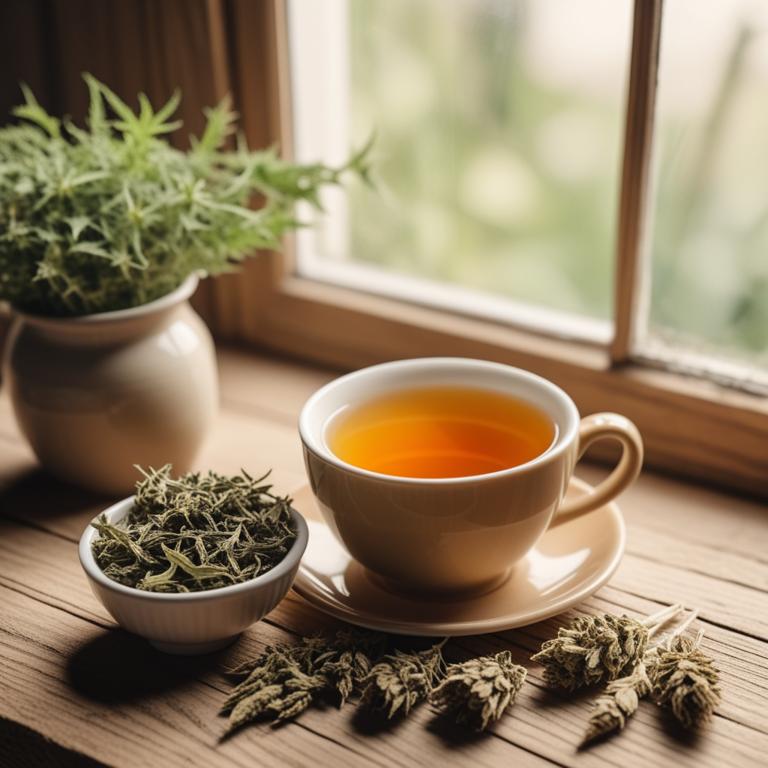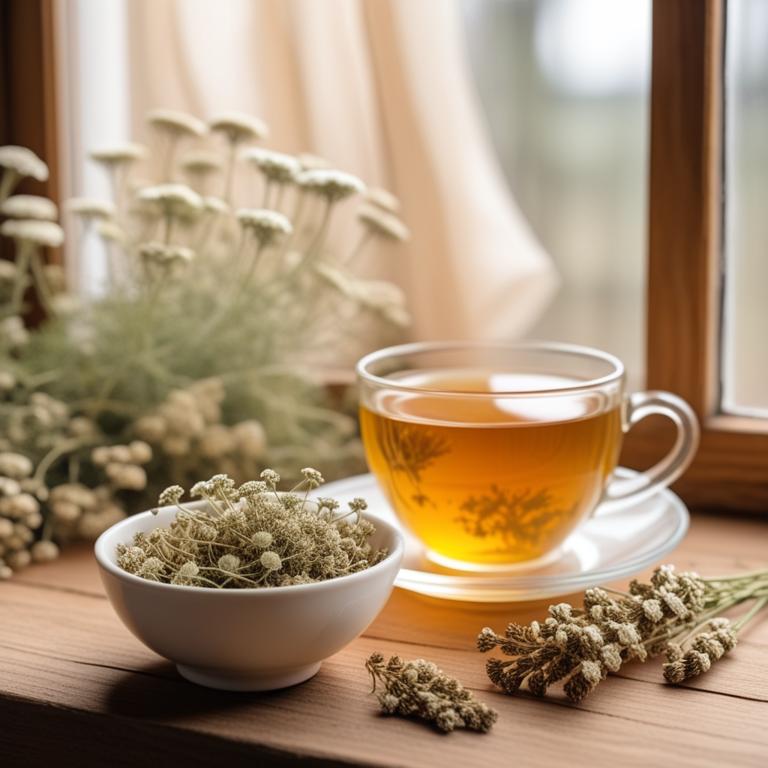7 Herbal Teas For Chickenpox

Herbal teas can be a great help when you or your child has chickenpox.
Chickenpox is a viral infection that causes an itchy rash, fever, and feeling unwell. Herbal teas like Echinacea purpurea, Melissa officinalis, and Urtica dioica can help to relieve symptoms and make you feel better. Echinacea purpurea is a well-known herb for its immune-boosting properties. It helps to fight off the virus and reduce the severity of the symptoms. By drinking Echinacea tea, you can help to reduce the risk of complications and make your recovery faster. Melissa officinalis, also known as lemon balm, has antiviral properties that can help to combat the chickenpox virus. It also has a calming effect, which can help to reduce stress and anxiety caused by the illness. Urtica dioica, or stinging nettle, has anti-inflammatory properties that can help to soothe the itchy rash and reduce swelling.
It also has antiviral properties that can help to fight off the virus. Drinking these herbal teas can bring many benefits to your life. For one, they can help to reduce the severity of symptoms, making you feel more comfortable and relaxed. They can also help to boost your immune system, making you less likely to get sick in the future. Additionally, they can be a natural and gentle way to help your body fight off the infection, without the need for harsh medications. In addition to their health benefits, herbal teas can also be a soothing and calming way to help you relax and unwind. They can be enjoyed hot or cold, sweetened or unsweetened, making them a great alternative to other drinks. It's worth noting that herbal teas should not be used as a replacement for medical treatment. If you or your child has chickenpox, it's essential to consult with a healthcare professional for proper diagnosis and treatment.
However, herbal teas can be a great complementary therapy to help manage symptoms and support the healing process.
- 1. Echinacea purpurea
- 2. Melissa officinalis
- 3. Urtica dioica
- 4. Eucalyptus globulus
- 5. Calendula officinalis
- 6. Achillea millefolium
- 7. Sambucus nigra
1. Echinacea purpurea

Echinacea purpurea teas contains bioactive constituents like alkylamides, caffeic acid derivatives, and flavonoids.
These compounds have anti-inflammatory properties that can help reduce the severity of chickenpox symptoms. The alkylamides in Echinacea purpurea have been shown to stimulate the immune system, which can aid in fighting off the varicella-zoster virus that causes chickenpox. The caffeic acid derivatives in the tea have antioxidant properties that can help protect the body from damage caused by free radicals during the infection.
By reducing inflammation and boosting the immune system, Echinacea purpurea teas may help alleviate some of the discomfort associated with chickenpox.
- Gather 2 tablespoons of dried Echinacea purpurea flowers and 1 cup of boiling water.
- Place the dried flowers in a tea infuser or a heat-resistant cup.
- Pour the boiling water over the flowers and let it steep for 5-7 minutes.
- Strain the tea into another cup and discard the flowers.
- Drink 1/2 cup of the tea 3 times a day to help soothe chickenpox symptoms.
2. Melissa officinalis

Melissa officinalis teas contains rosmarinic acid, apigenin, and luteolin as its bioactive constituents.
These compounds have anti-inflammatory and antiviral properties that help alleviate symptoms of chickenpox, such as itching and fever. The antiviral properties of rosmarinic acid and luteolin can inhibit the replication of the varicella-zoster virus, which causes chickenpox. Additionally, the anti-inflammatory properties of apigenin can reduce swelling and redness associated with the rash.
By reducing inflammation and inhibiting viral replication, Melissa officinalis teas can help alleviate symptoms of chickenpox and promote recovery.
- Gather ingredients: Melissa officinalis leaves (1 cup), boiling water (1 cup), honey (1 tablespoon), lemon juice (1 tablespoon)
- Dry Melissa officinalis leaves in a low-temperature oven (150°F) for 1 hour to reduce moisture
- Steep dried Melissa officinalis leaves in boiling water for 5-7 minutes, then strain the mixture
- Mix the tea with honey and lemon juice to taste, then drink 2-3 cups throughout the day
- Consult a doctor or healthcare professional before using Melissa officinalis tea for chickenpox treatment, especially for children and pregnant women
3. Urtica dioica

Urtica dioica teas contains bioactive constituents like flavonoids, phenolic acids, and saponins, which contribute to its therapeutic properties.
These compounds have anti-inflammatory and antioxidant effects, which can help reduce the severity of chickenpox symptoms such as fever and skin inflammation. The saponins in Urtica dioica teas have been shown to possess antiviral properties, which may help alleviate the viral infection that causes chickenpox. Additionally, the flavonoids and phenolic acids in Urtica dioica teas have been found to possess immunomodulatory effects, which can help regulate the immune response and potentially reduce the duration and severity of the illness.
Drinking Urtica dioica teas may help alleviate some of the symptoms associated with chickenpox by providing relief from fever, itching, and skin lesions.
- Gather 2 cups of fresh Urtica dioica leaves and flowers. Clean them with water.
- Boil 4 cups of water in a pot. Let it cool down for 5 minutes.
- Add 2 tablespoons of the cleaned Urtica dioica leaves and flowers to the cooled water. Let it steep for 5-7 minutes.
- Strain the mixture using a fine-mesh sieve or cheesecloth. Discard the solids.
- Drink 1/2 cup of the Urtica dioica tea, 3-4 times a day. You can also add honey to taste.
4. Eucalyptus globulus

Eucalyptus globulus teas contains flavonoids and tannins as active constituents.
These compounds have anti-inflammatory and antiviral properties that help soothe itchy skin and reduce fever associated with chickenpox. The flavonoids in Eucalyptus globulus also have antioxidant properties that can help fight off the infection and reduce the severity of symptoms. The antiviral properties of Eucalyptus globulus may also help reduce the replication of the varicella-zoster virus, which causes chickenpox.
Drinking Eucalyptus globulus tea may also help promote a faster recovery by reducing the duration of fever and discomfort.
- Gather 1 cup of fresh or dried Eucalyptus globulus leaves.
- Measure 1 tablespoon of the leaves and place them in a cup.
- Boil 1 cup of water and pour it over the Eucalyptus leaves in the cup.
- Let the mixture steep for 5-7 minutes, then strain it into another cup.
- Drink the tea 2-3 times a day to help soothe chickenpox symptoms.
5. Calendula officinalis

Calendula officinalis teas contains sesquiterpene lactones, triterpene acids, and carotenoids as its active constituents.
These compounds have anti-inflammatory, antimicrobial, and antioxidant properties that help to soothe and calm the skin. The anti-inflammatory properties of calendula can reduce redness and swelling associated with chickenpox, while its antimicrobial properties can help prevent secondary infections. The antioxidant properties of calendula can also help to reduce the severity and duration of the rash.
By reducing inflammation and promoting healing, calendula officinalis teas can help to alleviate the discomfort and pain associated with chickenpox.
- Gather 2 tablespoons of dried Calendula flowers and 1 cup of boiling water.
- Steep the Calendula flowers in the boiling water for 5-7 minutes.
- Strain the mixture into a cup using a tea strainer or cheesecloth.
- Add honey to taste, if needed, to make the tea more palatable.
- Give the tea to the person with chickenpox, ideally 2-3 times a day, to help soothe the skin and reduce itching.
6. Achillea millefolium

Achillea millefolium teas contains a variety of bioactive constituents, including flavonoids, sesquiterpenes, and phenolic acids.
These compounds have anti-inflammatory and antiviral properties that can help to soothe and calm the skin, reducing the severity of chickenpox symptoms. The sesquiterpenes in Achillea millefolium, such as achilleine and sesquiterpene lactones, have been shown to inhibit the replication of viruses, including those that cause chickenpox. Additionally, the flavonoids in the tea, including rutin and quercetin, have antioxidant properties that can help to protect the skin from damage and promote healing.
Drinking Achillea millefolium tea may help to reduce the fever, itching, and discomfort associated with chickenpox, making it a potentially useful natural remedy for this common illness.
- Gather 1 cup of dried Achillea millefolium leaves.
- Measure 250ml of water and bring it to a boil in a pot.
- Add 2 tablespoons of dried Achillea millefolium leaves to the boiling water.
- Reduce heat, let it simmer for 5-7 minutes, then strain the mixture.
- Drink 1/2 cup of the tea, 2-3 times a day, to help alleviate chickenpox symptoms.
7. Sambucus nigra

Sambucus nigra teas contains bioactive constituents like isorhapontigenin, sambunigrin, and flavonoids.
These compounds have anti-inflammatory and antiviral properties, which can help reduce the severity and duration of chickenpox symptoms. The antiviral properties of sambunigrin and flavonoids may prevent the herpes virus from replicating, while isorhapontigenin can help reduce inflammation and itching caused by the rash. The anti-inflammatory properties of Sambucus nigra teas can also help alleviate the fever and fatigue associated with chickenpox.
Additionally, the flavonoids present in Sambucus nigra teas have antioxidant properties, which can help protect the skin from damage caused by free radicals.
- Gather 25 grams of dried Sambucus nigra flowers and leaves. You can buy this at a health food store.
- Steep 1 teaspoon of dried Sambucus nigra in 1 cup of boiling water for 5-7 minutes.
- Strain the liquid and let it cool. You can store it in the fridge for up to 24 hours.
- For children over 1 year old, give 1/4 cup of the tea 3 times a day. For older children and adults, give 1/2 cup 3 times a day.
- You can also add honey or lemon to make the tea taste better. However, do not give honey to children under 1 year old.